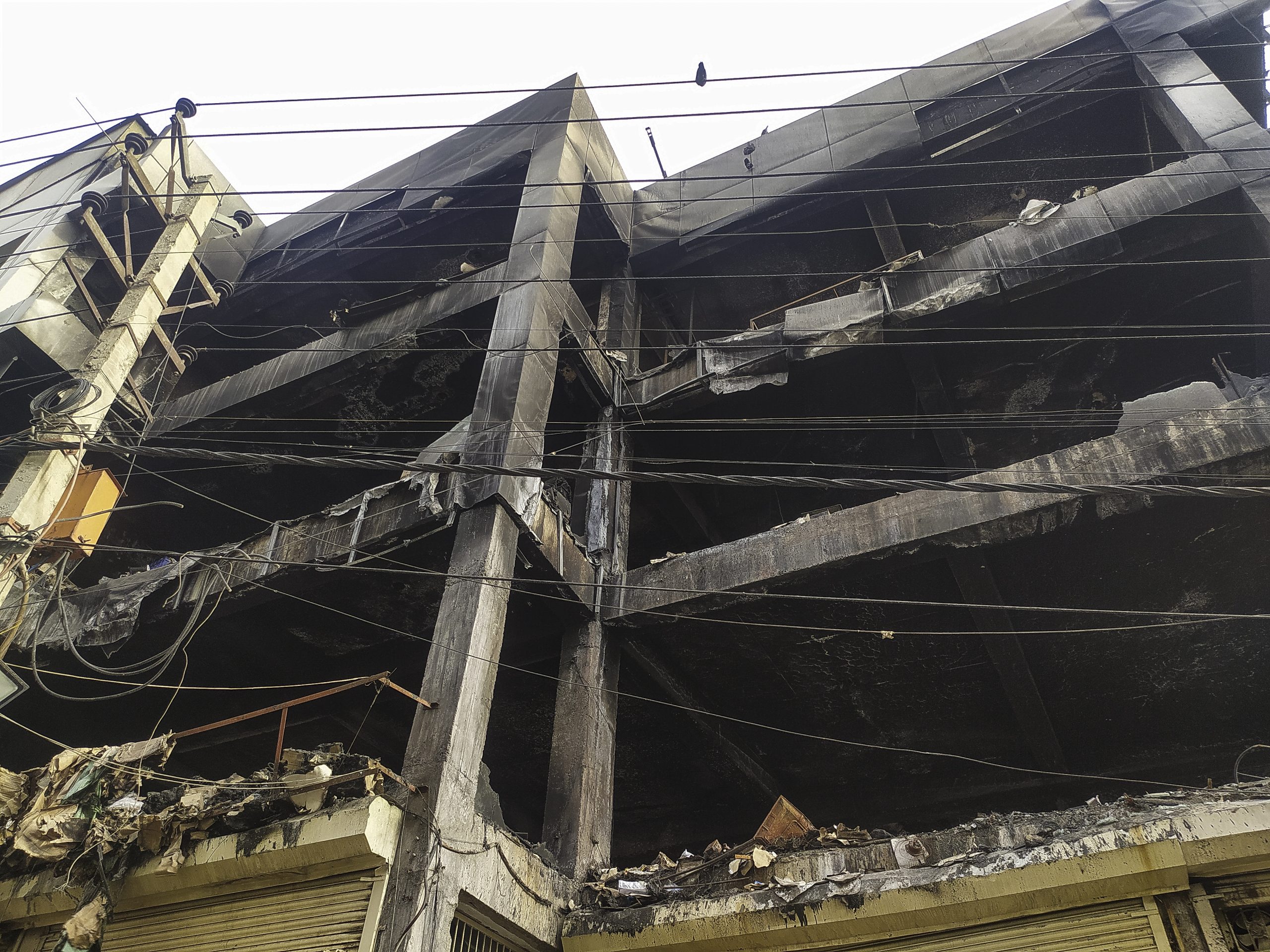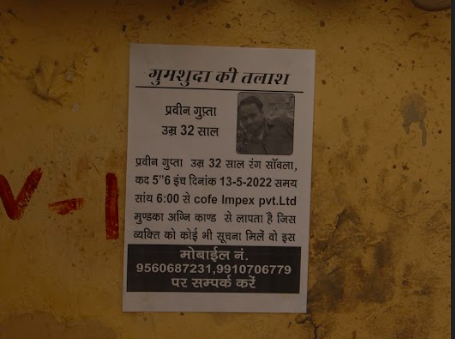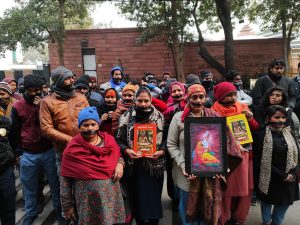In Delhi’s Illegal Factories, Hazards, Precarity Are Every Day Challenges For Women Workers

The recent industrial fire at an electronic assembly unit of Cofe Impex Pvt Ltd in west Delhi’s Mundka village has exposed the social and economic precarity of casual women workers, the hazardous operation of such sweatshops and poor implementation of safety regulations.
The factory, barely 500 metres from the Mundka metro station, sits on a narrow lane in one of Delhi’s many pockets where its rural and urban habitats, referred to as lal dora areas, mingle in unplanned and unregulated chaos. With liberal exemptions from development norms, these urban villages are full of haphazardly built, unauthorised and unsafe structures that are used as residences as well as offices and industrial units. In Mundka village, there are several homes within a few steps of the factory, some bungalows, some flats and some enclosed compounds where workers, scrap dealers and daily wage workers live.
On May 13, Aarti* (38) and her fellow workers were attending a meeting called by the factory owner, Manish Lakra, on the fourth floor of the building when the fire erupted. By around 4 PM, the entire building had a power outage and minutes later a giant cloud of smoke engulfed the entire floor, said Aarti. The windowless building was a death trap – it had no NOC from the fire department, no fire exit and a facade of thick fibreglass that made rescue work nearly impossible.
What saved many lives was the presence of a crane in the neighbourhood and the impromptu decision of its drivers to rescue those trapped in the building. “There was a stampede-like situation in the building. I could hear people screaming. Somehow I managed to reach the second floor. I saw people jumping on to the crane and joined them,” she said.
As she clambered on to the crane, Aarti bruised her arms and legs. “While I got injured, I’m grateful that I made out alive. It has been over a week but I still get nightmares of people screaming and shouting for help,” she said.
The fire killed 27 persons as per the official figures and of them 21 are reported to be women, as per multiple media reports (see here, here, and here). Most workers here, especially the women, were employed without any contract and paid paltry wages in cash.
‘Ease of Doing Violations’, the fact-finding report of a student fact finding team, Collective Delhi, estimates at least 18 such industrial fires in factory units across Delhi between 1997 and 2022. The report also concluded that the factory had not been inspected by Delhi government’s labour department, and it had not secured the requisite compliances from the fire department. Cofe Impex is listed as a registered company on the Ministry of Corporate Affairs’ website.
Labour activists also point to the dilution of the conditions in the Occupational Safety Health and Working Conditions (OSHWC) Code 2020 which allows unscrupulous employers to bypass safety regulations by keeping the number of workers low, or by keeping many of them off the books as was the case in Mundka.
Minors, women preferred labour profile
The Mundka unit destroyed in the recent fire engaged as many as 250-300 workers, of whom most were women, estimated workers and locals interviewed by Behanbox.
Workers like Aarti were required to put in a minimum of eight-hour shifts during which they assembled and packed electronic and surveillance equipment, including CCTVs. They are paid an average of Rs 6,500 a month in cash and are not entitled to any employment benefits. Aarti started working at the unit only two-three months ago to fund her children’s education.
When asked about the terms of her employment, Aarti maintained that she was hired without any contract or paper trail. The factory administration only noted her name and phone number, and assigned her tasks a day before she joined.
Experts believe that this allows employers to get away without paying any compensation or offering any kind of redressal in the event of an accident. “In the absence of a contract, a payment slip, or any other such document, these workers fall through the cracks and out of the purview of the law,” said Dipa Sinha, an assistant professor at the School of Liberal Studies, Ambedkar University, Delhi, who has researched extensively on labour issues.
The e-Shram portal launched by the Ministry of Labour and Employment, and the Code on Social Security, 2020 were supposed to register all informal workers but it has yet to be implemented fully so far, said Sinha. “This is the first level of precarity faced by these workers. In the absence of such a document or a labour card, they will be deprived of accessing any employment or social security benefits; especially those provisions under labour laws that are linked to the duration of employment: for instance, maternity benefits,” she explained.

Chandni Paswan (17), a Class 9 student, had worked at the factory unit for Rs 6,000 a month but left last year. “Once school reopened, my parents did not want me working there because we were often asked to work overtime,” she said.
Paswan, the daughter of a scrap dealer, wanted to support her family which had been hit by the COVID-19 pandemic and the ensuing lockdowns. “I worked there throughout the pandemic. Most girls (working) there were 18-25 years old and they mostly came from surrounding neighbourhoods – Bhagya Vihar, Nangloi, Punjabi Bagh, and Prem Nagar,” she recalled, as she stood in the lane that houses both her home and the charred remains of the factory.
Gender gap
There are fewer men visible at such units because of the poor wages. “Women work readily for smaller sums of money,” said Ramshesh Yadav, a scrap seller, who was among the first responders to the fire. “Men do not work for such low wages. And the work does not involve any heavy lifting.” Several small business owners in the area repeated this view.
Yadav, whose home is half a kilometre from the fire-hit assembly unit, had helped rescue around 50 women.

Many workers, who worked in the factory, are missing, while several have gone back to their villages, Paswan said. “A week (has passed) since the fire, and people still come to check for missing family members who worked here.”
Mukesh Kumar (23), a welder who works for an iron manufacturer in the official Mundka industrial area, belongs to a family of migrants from Bihar. His 52-year-old grandfather worked at the assembly unit and suffered injuries when he jumped out to escape the fire. “He was rushed to Sanjay Gandhi Memorial Hospital where he received first-aid and treatment,” he said. “But we have neither received any compensation nor any offer of support from the factory administration. We had to send our grandfather back to our village in Bihar.”
Kumar’s grandfather was being paid Rs 8,500, a higher wage than what the women earn. The gender wage gap is not unique to this factory and is common in the informal economy. There are approximately 96 million women in India’s informal workforce, as per the ‘Women in The Informal Economy’, a 2021 report of the Initiative for What Works to Advance Women and Girls in the Economy (IWWAGE), a gender research and advocacy organisation, and the Institute of Social Studies Trust (ISST).
“Differential wages is an accepted norm in the informal economy. Women’s work is not even considered work,” said Sinha. “Since women’s work is devalued and undermined, women often do not view themselves as the primary breadwinners of the family. That is even if their income is being used to meet essential expenses within the households.”
In addition to social and economic precarity, women workers are also vulnerable to sexual and physical violence, said activists and lawyers. Behanbox had recently reported on how a Tamil Nadu-based Dalit women’s labour union wrested their right to safety at work after the alleged rape and murder of a 21 year-old garment worker by her supervisor.
‘Ladders and ropes’ for exits
Welder Mukesh Kumar has not been able to rejoin work at his factory because it, and several other units in the area, have stopped operations fearing a crackdown in the aftermath of the fire. His factory, he says, has “ladders and ropes” in place to help them exit the building in case of an accident. Cofe Impex did not even have that, he said.
“The factory unit had only one staircase for entry and exit. Can you imagine what it would have been if more than 200 workers used the same exit to escape the fire?” he asked.
Collective Delhi reported that no safety norms had been followed, as we said earlier. Tenant verification, mandated by the Delhi Police’s order issued under Section 144 of the Criminal Procedure Code, had not been carried out. And the factory had not been scrutinised by Delhi government’s labour department, as required under the Factories Act, 1948.
“Most safety norms were being flouted at the factory unit. They were not following any coded safety provisions either,” said Amartyajyoti Basu, member of Collective.
According to the Master Plan for Delhi 2021, only 28 domestic small-scale industries are allowed operations in residential areas such as matchstick making, incense manufacturing or garland making units. However, the Delhi State Industrial and Infrastructure Development Corporation (DSIIDC) had identified almost 52,000 illegally operating industrial units operating from non-conforming/residential areas of the city. The Delhi government had subsequently reported the closure of approximately 22,000 such units to the National Green Tribunal. According to the report, 30,000 illegal units continued to remain operational.
Not accident, but neglect
While the official data on the number of fatal and non-fatal industrial accidents in Delhi per year, collected by the office of NCT government’s Labour Commissioner shows a downward trend – from 1214 in 1988 to 40 in 2009 – Das argues that it does not represent the real scale of such disasters. The webpage was last updated in 2018, and data for the years after 2009 have not been published.
Over 8,000 ‘industrial accidents’ occured in Indian factory units claiming the lives of 6,368 employees between 2014 and 2017, as per IndustriALL, a global labour union.
Labour rights lawyer Maitreyi Krishnan believes that such disasters point to the complete failure of the government to enforce labour laws. “The Constitution requires the government to take measures to ensure and improve the safety of the workers. It is also important that the language used for such incidents is corrected. The usage of the word ‘accident’ shows as if such incidents just happen and are, therefore, not preventable. However, these are a direct result of the state’s negligence and apathy towards the workers’ plight,” she pointed out.
Krishnan argued that the new labour laws allows for the dilution of enforceable provisions. “For instance, the Occupational Safety Health and Working Conditions (OSHWC) Code 2020 applies only to establishments that have more than 20 workers if they have an official power connection, and more than 40 workers if they don’t have the power aid supply. This was 10 and 20 in earlier laws. And for contractual workers, the minimum threshold was 20 which has now been raised to 50. This increase in threshold will now allow more units to be able to operate outside the legal purview since the Act itself will not be applicable to smaller units,” she explained.
Many of these factories have been found to underreport the number of employees working under them, said Das and his team at Collective. “They often show only a few employees on paper when they file income tax returns to avoid paying taxes and evade labour laws.”
Both Sinha and Krishnan pointed to the fact that factory inspectors are now described as “facilitators” under the OSHWC code. This, they argued,has significantly reduced the powers of the inspectors who are no longer allowed to carry out surprise checks and are required to do web-based inspections.
“As a result there are no mechanisms to monitor and regulate these factories and it is almost as if the violation of workers’ rights has been legally sanctioned,” said Krishnan.
[*Names changed to protect identity]
We believe everyone deserves equal access to accurate news. Support from our readers enables us to keep our journalism open and free for everyone, all over the world.




